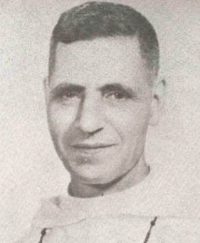After yesterday’s bombings, the bomber planes merely hovered around Manila.
I made a quick round of the site of the tragedy so that the ruins would not affect me too much. I noticed that a bomb fell on the big courtyard near our dining room. Its shrapnels spread out like a fan, perforating our refrigerator. The posts and beams of the chapel here still burning. The chapel was completely destroyed inside, except the portion of the choir. Another bomb had bored through the wall, hitting the crucifix and shattering it to pieces.
Also our storeroom was still burning. Canned goods burst open under the heat of the fire… Thousands of pesos gone in smoke.
I observed the hole caused by the bomb which exploded at the base of a column about four meters away from our air raid shelter. I made a round of the new building. From the outside, it looked intact, but nothing was more deceiving. Almost all the wood inside was burned or scorched. The doors and windows are either burned or destroyed by the impact and not one of them is of any use. The roof of the fourth floor facing Beaterio Street, and which was made of corrugated iron sheets, fell on the floor when the wood supporting it was consumed by the fire.
All over are ruins, piles of half-burned wood, mounds of twisted metal… a big heap of debris.
I went up the roof garden. From this vantage point, I had a panoramic view of the whole devastated area. Seven blocks of the Walled City were now nothing but a heap of rubble. Almost all their inhabitants had fled to safer places, and I could not but recalled Jeremiah’s words: “How lonely has been left a city, full of people…”
Hunted by the thought of the aerial visitors, I cut short my lamentations and made a hurried round of the vicinity of Santo Domingo. For three days now, the pillars and beams of such sizes that two men could hardly embrace them, have been burning. Some of the Fathers tried the flames and muddy water in search of anything worth salvaging: medals and charred rosaries, utensils and other metal objects which the fire had not consumed.
I could see a number of cars—more than twenty of them—abandoned along the sidewalk near Santo Domingo, Santo Tomas and Tesorería. Nothing was left of these cars but their steel frameworks. One of them was hurled against the wall of the Treasury, half buried in it. The Magallanes Drive and the Plaza de España were pockmarked with craters.
That night, using blowtorches, we forced open the steel door of the safety vault of the Procurator’s office. The venerable statue of the Virgin, the jewelry and other marble statues, together with the great portion of the archives, remained intact in spite of the fire that surrounded the vault for three days. Braving the scorching heat inside the vault, the priests, 15 of them, finished the long salvage work at around 11:00 in the evening. Fr. Ortega stayed in his knees with the Virgin’s statue in the wagon while on the way to Sulucan. With the help of about twelve men armed with pistols and six policemen who stood on guard, they safely deposited the precious treasures in the offices of the University of Santo Tomas.
People were asking, “Did the Japanese bomb Letran with incendiary bombs?” Many thought so, considering the big fires caused by the bombings. However, I am not sure since they did not contain combustible liquid. The steel frame simply contained shrapnels. We, who were at Letran during the bombings, saw that fire did not immediately flare up after the explosions. Some of the Fathers found fragments of bombs which were incandescent. One of them had the inscription, “Made in Japan. 30 kilos.” Some others thought that the fires were due to broken electrical installations.
